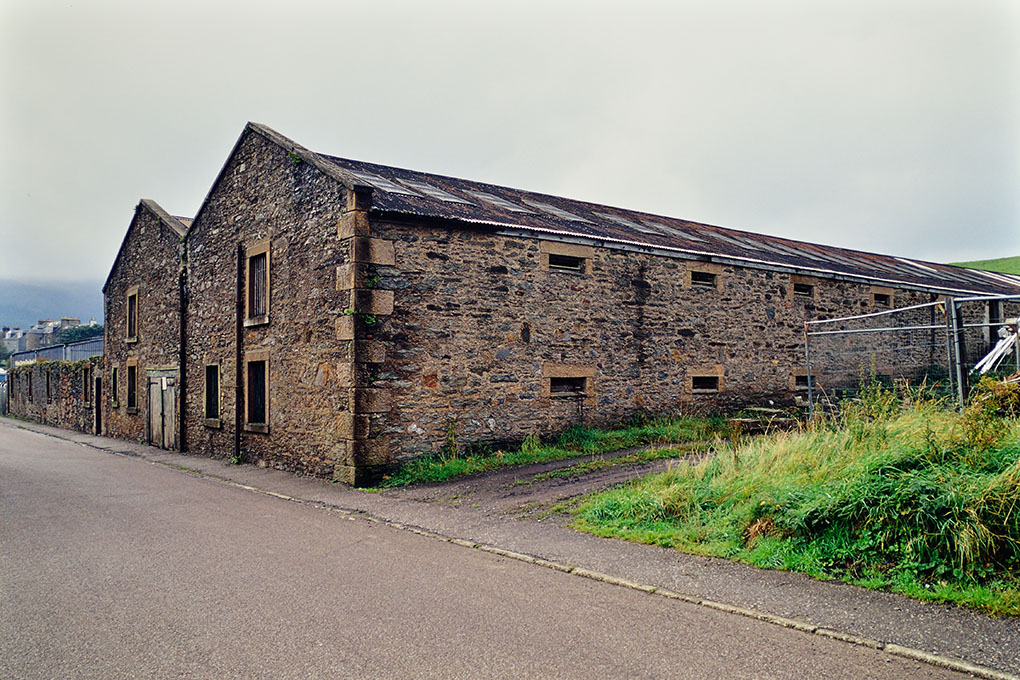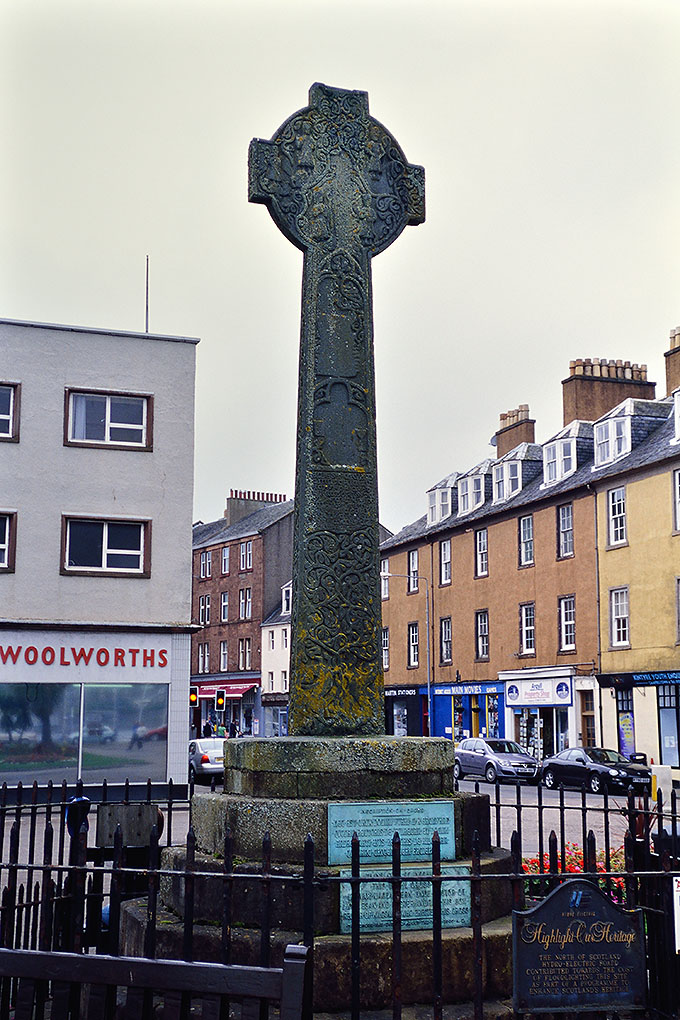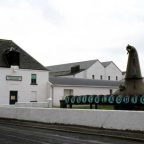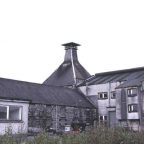Glen Nevis Distillery(17 Sep 2008)
Glen Nevis蒸留所は1877年に建設された町で2番目に新しい蒸留所でGlebe Street沿いに建てられた。創業者はCampbeltownのウィスキー産業を牽引してきたDuncan MacCallum。当時の最新式設備を導入し、効率よく生産ができる近代的な蒸留所だった。
1887年にScotch Whisky Distillers Ltdに買収されたGlen Nevis蒸留所は、その会社が1889年に倒産した後、創業者であるDuncan MacCallumによって買い戻されたが、1896年にScotia蒸留所(現在のGlen Scotia蒸留所)を所有していたStewart Galbraith社によって買収された。そして多くのほかの蒸留所と同じように、1919年にWest Highland Malt Distillers社によって買収された。ウィスキーの製造は1923年に停止された。
その後、Duncan MacCallumは1930年12月に、多くの蒸留所が水源としていたCrosshill Lochで謎の自殺を遂げた。
Glen Nevis蒸留所は1936年にArdlussa蒸留所と共に新しい会社によって購入され、ウェアハウスだった建物にブレンドと瓶詰の工場が造られた。
現在蒸留所の敷地はArdlussa蒸留所も含めて建設会社の作業場となっている。そしてウェアハウスの一部は残っている。
1887年にScotch Whisky Distillers Ltdに買収されたGlen Nevis蒸留所は、その会社が1889年に倒産した後、創業者であるDuncan MacCallumによって買い戻されたが、1896年にScotia蒸留所(現在のGlen Scotia蒸留所)を所有していたStewart Galbraith社によって買収された。そして多くのほかの蒸留所と同じように、1919年にWest Highland Malt Distillers社によって買収された。ウィスキーの製造は1923年に停止された。
その後、Duncan MacCallumは1930年12月に、多くの蒸留所が水源としていたCrosshill Lochで謎の自殺を遂げた。
Glen Nevis蒸留所は1936年にArdlussa蒸留所と共に新しい会社によって購入され、ウェアハウスだった建物にブレンドと瓶詰の工場が造られた。
現在蒸留所の敷地はArdlussa蒸留所も含めて建設会社の作業場となっている。そしてウェアハウスの一部は残っている。
Glen Nevis Distillery was second newest distillery in Campbeltown, it was built along Glebe Street in 1877. The founder was Duncan MacCallum who led whisky industry of Campbeltown. The distillery was modern and produced efficiently, it had much modern equipments for the era.
Glen Nevis Distillery was bought by Scotch Whisky Distillers Ltd in 1887 and bought back by Duncan MacCallum after Scotch Whisky Distillers went bankrupt in 1889. However, The distillery was bought by Stewart Galbraith, who owned Scotia Distillery(later Glen Scotia). After that, it was bought by West Highland Malt Distillers and closed in 1923, like so many other distilleries in Campbeltwn.
Duncan MacCallum committed mysterious suicide in December 1930 at Crosshill Loch, where many distilleries in Campbeltown used as a water source.
Glen Nevis Distillery was bought by a new company in 1936 with Ardlussa Distillery, which was next to Glen Nevis. Warehouses were converted to a blending and bottling plant.
Today, the distillery site (including Ardlussa) is a yard of construction company and a part of the warehouses are remained.
Glen Nevis Distillery was bought by Scotch Whisky Distillers Ltd in 1887 and bought back by Duncan MacCallum after Scotch Whisky Distillers went bankrupt in 1889. However, The distillery was bought by Stewart Galbraith, who owned Scotia Distillery(later Glen Scotia). After that, it was bought by West Highland Malt Distillers and closed in 1923, like so many other distilleries in Campbeltwn.
Duncan MacCallum committed mysterious suicide in December 1930 at Crosshill Loch, where many distilleries in Campbeltown used as a water source.
Glen Nevis Distillery was bought by a new company in 1936 with Ardlussa Distillery, which was next to Glen Nevis. Warehouses were converted to a blending and bottling plant.
Today, the distillery site (including Ardlussa) is a yard of construction company and a part of the warehouses are remained.
Campbeltown Cross(14 Sep 2008)
港のOld Quay近くにあるキャンベルタウンクロスは14世紀頃に造られた中世のスコットランド文化を伝える代表的な石造物で、その彫刻からアイオナ島のIona Abbeyで造られたものとされる。どのような経緯でキャンベルタウンに運ばれたのかはわかっていないがキャンベルタウンが自治都市(Burgh)になった1609年の後と思われる。1680年には既に存在していたという。
当初はメインストリートの真ん中、クロスストリートと交わる辺りに設置されていたが第二次世界大戦中に戦災を避けるためにKilkerran墓地に移され、戦後現在の位置に設置された。
海に近くなったので潮風の影響を受けて最近は彫刻の傷みが懸念されているらしい。この場所ならば当たり前と思うんだけど・・・
日本だったらレプリカを設置して本物は博物館にでも保存するだろう。文化財に対する考え方が日本と随分違うように思う。
当初はメインストリートの真ん中、クロスストリートと交わる辺りに設置されていたが第二次世界大戦中に戦災を避けるためにKilkerran墓地に移され、戦後現在の位置に設置された。
海に近くなったので潮風の影響を受けて最近は彫刻の傷みが懸念されているらしい。この場所ならば当たり前と思うんだけど・・・
日本だったらレプリカを設置して本物は博物館にでも保存するだろう。文化財に対する考え方が日本と随分違うように思う。
Campbeltown Cross, which stands near the Old Quay, was made in 14th century and it is a representative stonework which hands down the mediaeval Scottish culture.It seems most likely that Campeltown Cross was carved at Iona Abbey in Isle of Iona because of the carving. It is unknown when and why the cross was moved to Campbeltown. However, it must have been after 1609 when Campbeltown became a burgh and certainly before 1680.
Campbeltown Cross was originally set up in the centre of Main Street, near a crossing of Cross Street, but was moved to Kilkerran Cemetery for safety during World War Two. The cross was sited current position after the war.
It would be concerned about a damage of carving under the influence of a sea breeze because of the position became near to the sea. I may expect a result if it is in this position.
If it is in Japan, a replica would be installed in outdoor, the original would stored to a museum. I think that it is very different approach to cultural assets between UK and Japan.
Campbeltown Cross was originally set up in the centre of Main Street, near a crossing of Cross Street, but was moved to Kilkerran Cemetery for safety during World War Two. The cross was sited current position after the war.
It would be concerned about a damage of carving under the influence of a sea breeze because of the position became near to the sea. I may expect a result if it is in this position.
If it is in Japan, a replica would be installed in outdoor, the original would stored to a museum. I think that it is very different approach to cultural assets between UK and Japan.






